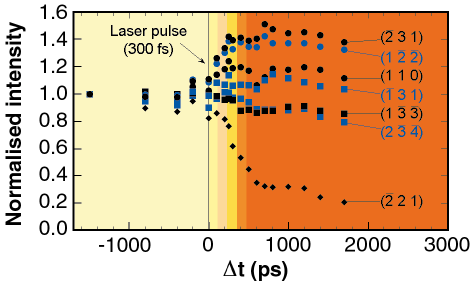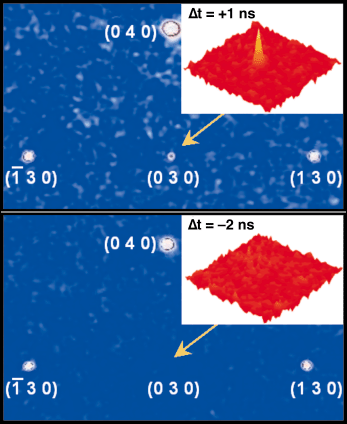- Home
- Users & Science
- Scientific Documentation
- ESRF Highlights
- ESRF Highlights 2002
- Materials Science
- Photo-induced Ferroelectric Structural Order Evidenced by 100 Picosecond Diffraction
Photo-induced Ferroelectric Structural Order Evidenced by 100 Picosecond Diffraction
A new type of manipulation of matter by light, in the picosecond (ps) or femtosecond (fs) timescales, has recently emerged by virtue of optically-controlled phase transitions. In some materials, molecular multistability between degenerate or quasi-degenerate states involves changes in the molecular identity, such as charge and/or spin. The structural relaxations of the electronic excited states following the absorption of photons are not independent processes, as in conventional excitonic or photo-chemical ones, but entail a photo-induced phase transformation towards a new lattice structure and electronic order. It is exemplified in some mixed-stack charge-transfer molecular materials that are readily tuned between competing neutral and ionic ground states. The sequence of alternating donor (D) and acceptor (A) molecules stimulates cooperative electron transfer, giving rise to a chain multistability and phase transition between regular neutral state D0 A0 D0 A0 D0 A0 D0 A0 and polar dimerised ionic state (D+A) (D+A) (D+A) (D+A) Structural and electronic changes are strongly coupled, as in the prototype compound TTF-CA (tetrathiafulvene-p-chloranil). The photoinduced neutral-ionic transformation takes place on the 100 ps time scale [1], whereas the life time of the photoinduced metastable state is in the range of few nanoseconds to a few microseconds. These phenomena are highly non-linear, since the efficiency, as large as a few hundreds of DA pairs transform per photon, is not simply proportional to the total absorbed photon energy. The advent of time-resolved photo-crystallography based on recent instrumentation developments gives an outstanding opportunity to observe directly the photoinduced structural changes with the appropriate time resolution.
 |
|
Fig. 83: Relative intensity of some Bragg reflections, measured at 0.753 Å, vs the delay between the laser pump and the X-ray probe. 11 K above the phase transition, a large structural reorganisation associated with the neutral-to-ionic transformation follows the laser irradiation. After 500 ps the light-driven metastable state is established. The delay dependence of the colour of the background reflects the change of reflectivity associated with the change in electronic state [1]. |
The 100 ps time-resolved crystallography experiments on the neutral to ionic photo-induced transformation were performed at beamline ID09TR, using the optical pump and X-ray probe method [2]. An optical infra-red femtosecond pulse switches the material from a neutral to a metastable ionic state, followed by the recovery to the stable state. It is then possible to probe the sample stroboscopically by recording the diffraction pattern, for different delays between the X-ray and the laser pulses. Following laser irradiation, drastic changes are observed in the intensity of several Bragg reflections (Figure 83), some decreasing and others increasing. These intensity changes are a direct signature of a strong structural reorganisation in the photo-induced state, characteristic of a phase transformation (coherent three-dimensional domains) and not of independent local photo-induced distortions as in photosensitive proteins. The transformation is completed in less than 500 ps, in good agreement with optical studies [1]. One of the most salient features is the direct observation from the diffraction patterns of the symmetry lowering in the photo-induced state. Indeed, new weak Bragg peaks characteristic of a photo-induced ferroelectric organisation is observed as shown in Figure 84 +1 ns after the laser pulse. These new reflections are a direct signature of the 3D long-range ferroelectric order nature of the photo-induced state, similar to the low temperature one, also confirmed by preliminary refinement of the structures before and after laser irradiation which indicate photo-induced changes at the molecular level.
 |
|
|
Still a dream only a decade ago, the success of 100 picosecond-scale crystallography on ID09TR gives outstanding possibilities to study photo-induced phase transformations. Moreover it stimulates future research towards photo-induced precursor cooperative phenomena such as the formation of nanoscale 1D charge-transfer domains, as successfully done at thermal equilibrium.
References
[1] S. Koshihara, Y. Takahashi, H. Sakai, Y. Tokura, T. Luty, J. Phys. Chem. B103, 2592 (1999).
[2] S. Techert, F. Schotte, M. Wulff, Phys. Rev. Lett. 86, 2030 (2001), and citations within.
Principal Publication and Authors
E. Collet (a), M.H. Lemée-Cailleau (a), M. Buron (a), H. Cailleau (a), S. Techert (b), M. Wulff (c), T. Luty (d), S. Koshihara (e), M. Meyer (f), L. Toupet (a), P. Rabiller, submitted.
(a) Groupe Matière Condensée et Matériaux, Université de Rennes1 (France)
(b) Max Planck Institut for Biophysical Chemistry, Göttingen (Germany)
(c) ESRF
(d) Institute of Physical and Theoretical Chemistry, Wroclaw (Poland)
(e) Department of Materials Science, Tokyo Institute of Technology (Japan)
(f) Oxford Diffraction Poland, Wroclaw (Poland)
 t = 2 ns) and after (
t = 2 ns) and after (


